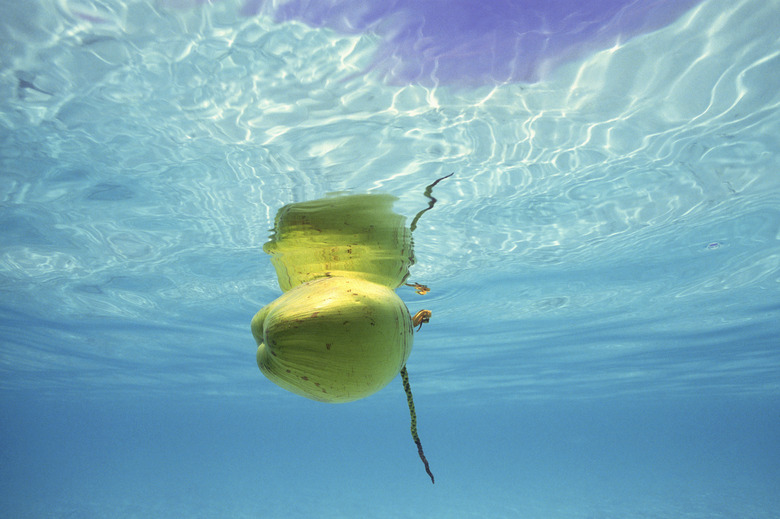Characteristics Of Fruit & Seeds Dispersed By Water
The dispersal of seeds from the parent plant is an essential part of many plants' life cycle – the study of this is termed dispersal biology. Seed dispersal allows plants to colonize new environments and reduce competition from the parent for light, water and nutrients. Some seeds are also designed so that they are deposited in environmental conditions favorable for germination.
How Do Plants Disperse Seeds?
How Do Plants Disperse Seeds?
Plants have evolved several types of seed dispersal techniques. Seed dispersal by wind is a common technique. Seeds may have fluffy structures to help catch the wind, like you see in dandelions, or grow wing-like structures that enable them to glide a considerable distance, like the seeds of the sycamore. Another vector is animals. Some seeds may have hooks or spines to catch in the fur of passing animals. Others are contained in a fruit, to be eaten and later excreted with the seeds intact. Some plants scatter their seeds through a build-up of pressure within the seed capsule, to be released with explosive force. Plants that grow in or near aquatic environments may use water as a means of seed dispersal.
Plants That Use Water for Seed Dispersal
Plants That Use Water for Seed Dispersal
To enable seed dispersal by water, plants must have access to moving bodies of water. This may be a breeze on a lake, a flowing river or stream or the movement of tides in the ocean. Plants may hang over the water, as do willows, or grow directly in the water like waterlilies. Others may produce seeds that fall to the ground but are then carried by water during high tides or flooding events.
Seed Adaptation for Water Dispersal
Seed Adaptation for Water Dispersal
Of the many characteristics of fruits and seeds that are dispersed by water, buoyancy is the most important. Buoyancy enables seeds to float on the water's surface. This can be achieved by being very small and lightweight, such as silver birch, foxglove and harebell seeds. Other seeds are larger but have air pockets or other internal structures that make them less dense than water (hence allowing them to float).
This buoyancy is characteristic of seeds that grow into terrestrial plants, as it allows the seed to be deposited onto land. These often have fruit with water inside to sustain them during dispersal.
For aquatic plants such as water lilies, the seed is initially buoyant due to an air-filled coating; however, this rapidly decays and the seed sinks to the river or lake bed. The seed can then be further dispersed by water currents, and this ensures that they stay in permanently wet environments where they can germinate and grow.
Water-borne seeds often have a thick outer layer to protect the seed from water infiltration, especially in saltwater environments. If water comes in contact with the seed embryo, it will fail to germinate.
Coconut Seed Dispersal
Coconut Seed Dispersal
Coconuts have adapted for long-distance travel in the ocean. They are buoyant and can survive more than 120 days in seawater. They have a thick protective layer to keep out salt water and they have large quantities of meat and milk in the nut. This provides energy, water and nutrients to help the germinating plants establish in poor, sandy coastal soils.
Mangrove Seed Dispersal
Mangrove Seed Dispersal
All mangroves disperse their seeds via water and have evolved sophisticated seed structures to facilitate this. Mangrove seeds require a period of immersion in sea water in order to germinate and can remain viable for up to a year in such conditions.
Many seeds are tube-shaped, and when ripe they fall into the water where they float horizontally, allowing them to be spread by ocean currents. In time, they will change position to float vertically, which allows them to lodge into mud and silt in shallow waters and commence growing. This process can be hastened by the presence of brackish water, as these waters often indicate a suitable germination environment for the seed.
Mangrove seeds can use other methods of dispersion in conjunction with water. The cannonball mangrove produces seeds in densely packed pods which burst upon ripening, scattering the seeds into the water. The looking-glass mangrove has a thick ridge along one side, which is believed to catch the wind and help with dispersal.
Cite This Article
MLA
Michelle, Meg. "Characteristics Of Fruit & Seeds Dispersed By Water" sciencing.com, https://www.sciencing.com/characteristics-of-fruit-seeds-dispersed-by-water-13428034/. 30 September 2021.
APA
Michelle, Meg. (2021, September 30). Characteristics Of Fruit & Seeds Dispersed By Water. sciencing.com. Retrieved from https://www.sciencing.com/characteristics-of-fruit-seeds-dispersed-by-water-13428034/
Chicago
Michelle, Meg. Characteristics Of Fruit & Seeds Dispersed By Water last modified August 30, 2022. https://www.sciencing.com/characteristics-of-fruit-seeds-dispersed-by-water-13428034/
